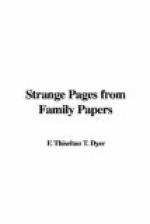A curious and remarkable custom which prevailed more or less down to the present century was that of heart burial. In connection with this strange practice numerous romantic stories are told, the supreme regard for the heart as the source of the affections, having caused it to be bequeathed by a relative or friend, in times past, as the most tender and valuable legacy. In many cases, too, the heart, being more easy to transport, was removed from some distant land to the home of the deceased, and hence it found a resting place, apart from the body, in a locality endeared by past associations.
Westminster Abbey, it may be remembered, contains the hearts of many illustrious personages. The heart of Queen Elizabeth was buried there, and it is related how a prying Westminster boy one day, discovering the depositories of the hearts of Elizabeth and her sister, Queen Mary, subsequently boasted how he had grasped in his hand those once haughty hearts. Prince Henry of Wales, son of James I., who died at the early age of eighteen, was interred in Westminster Abbey, his heart being enclosed in lead and placed upon his breast, and among further royal personages whose hearts were buried in a similar manner may be mentioned Charles II., William and Mary, George, Prince of Denmark, and Queen Anne.
The heart of Edward, Lord Bruce, was enclosed in a silver case, and deposited in the abbey church of Culross, near the family seat. In the year 1808, this sad relic was discovered by Sir Robert Preston, the lid of the silver case bearing on the exterior the name of the unfortunate duellist; and, after drawings had been taken of it, the whole was carefully replaced in the vault; and in St. Nicholas’s Chapel, Westminster, was enshrined the heart of Esme Stuart, Duke of Richmond, where a monument to his memory is still to be seen with this fact inscribed upon it.
Many interesting instances of heart burial are to be found in our parish churches. In the church of Horndon-on-the-Hill, Essex, which was once the seat of Sir Thomas Boleyn, a nameless black marble monument is pointed out as that of Anne Boleyn. According to a popular tradition long current in the neighbourhood, this is said to have contained the head, or heart. “It is within a narrow seat,” writes Miss Strickland, “and may have contained her head, or her heart, for it is too short to contain a body. The oldest people in the neighbourhood all declare that they have heard the tradition in their youth from a previous generation of aged persons, who all affirm it to be Anne Boleyn’s monument.” But, it would seem, there has always been a mysterious uncertainty about Anne Boleyn’s burial place, and a correspondent of the Gentleman’s Magazine (October, 1815), speaks of “the headless remains of the departed queen, as deposited in the arrow chest and buried in the Tower Chapel before the high altar. Where that stood, the most sagacious antiquary, after a lapse of more than 300 years, cannot now determine; nor is the circumstance, though related by eminent writers, clearly ascertained. In a cellar, the body of a person of short stature, without a head, not many years since, was found, and supposed to be the reliques of poor Anne, but soon after it was reinterred in the same place and covered with earth."[51]




